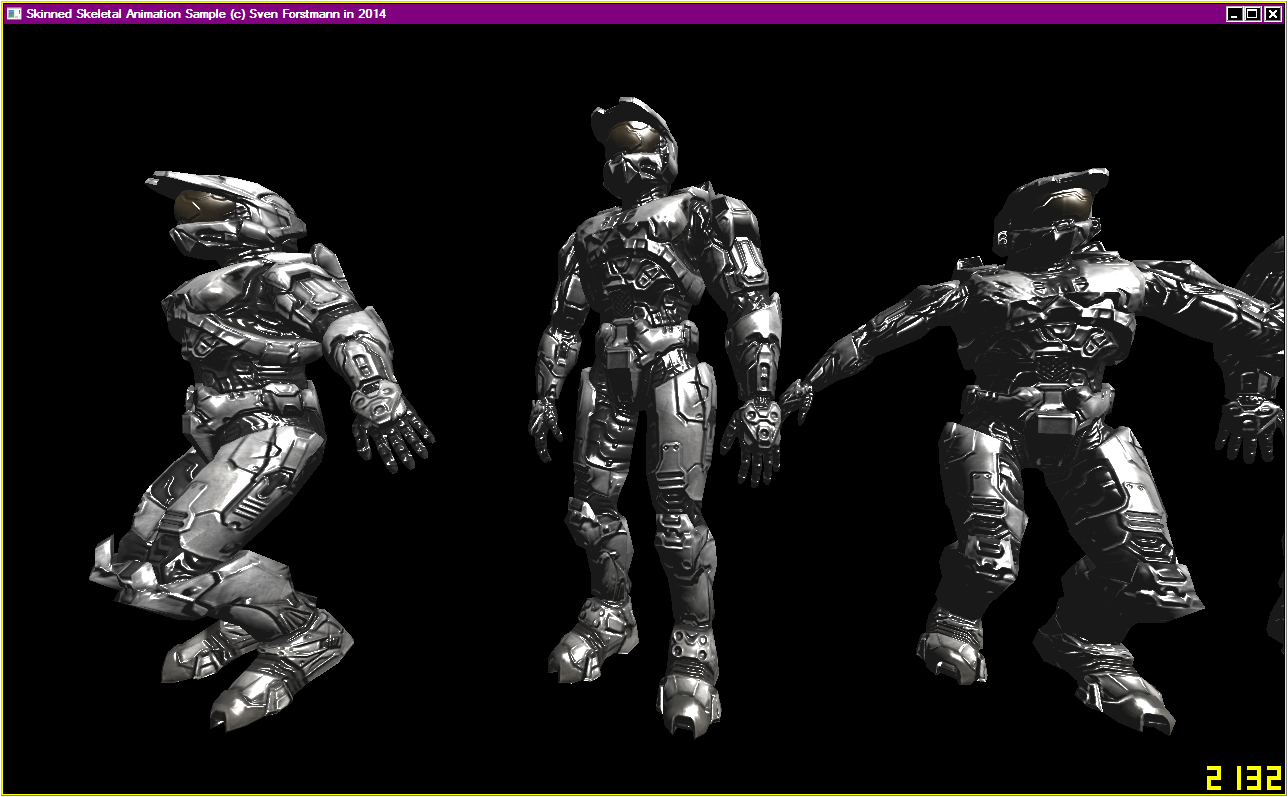Today I completed a skinned skeletal animation tutorial, which is very helpful if you are just about to start with game development.
Different from the other tutorials I found in the web, this one is very light weight ( < 800 lines for the main mesh & animation code ) and works well with most modeling environments.
Summary
It has the following properties / features:
- GPU Skinning / Matrix Palette Skinning
- Bump Mapping (automatic normal map generation)
- Spheric environment mapping
- Ogre XML Based
- Shaders in GLSL
- Visual Studio 2010
- Select LOD level with F1..F5
It is ready to use, which means you can load and display the animated models in a few lines of code:
static Mesh halo("halo.material",// required material file)
"halo.mesh.xml",// required mesh file
"halo.skeleton.xml");// optional skeleton file
int idle = halo.animation.GetAnimationIndexOf("idle");
halo.animation.SetPose(idle, // animation id (2 animations, 0 and 1, are available)
time_elapsed); // time in seconds. animation loops if greater than animation time
halo.Draw( vec3f(0,0,0), // position
vec3f(0,0,0), // rotation
0); // LOD level .
Also getting a bone matrix to put a weapon in the hand of the player e.g. is very simple:
int index = halo.animation.GetBoneIndexOf("joint1");
matrix44 m = halo.animation.bones[ index ].matrix;
.
Setting the arm joint individually for shooting a weapon e.g. works as follows:( press F6 in the demo ):
// get the index
int index = halo.animation.GetBoneIndexOf("joint2");
// get / modify / set the matrix
matrix44 m = halo.animation.bones[ index ].matrix;
m.x_component()=vec3f(1,0,0);
m.y_component()=vec3f(0,1,0); // set the rotation to identity
m.z_component()=vec3f(0,0,1);
halo.animation.bones[ index ].matrix=m;
// re-evaluate the child bones
loopi(0,halo.animation.bones[ index ].childs.size())
{
halo.animation.EvalSubtree(
halo.animation.bones[ index ].childs[i], // bone id
halo.animation.animations[0], // animation
-1); // key frame -1 means not use the animation
}
.
Workflow:
- Design the Model in Maya/MAX/Blender/etc.
- Export the model using the OgreExporter
- Convert the model from Ogre binary to Ogre XML (batch file is included)
- Load the model in the tutorial code
Main Skinning in GLSL:
The main skinning is done in the vertex shader and only requires a few lines.
For the shader, the skinning weights are stored in the color information as 3 floats.
The bone IDs are unpacked from the w coordinate of the position information.
The bone matrixes are stored as simple matrix array.
uniform mat4 bones[100];
uniform int use_skinning;
void main(void)
{
mat4 mfinal = gl_ModelViewMatrix ;
// skinning
if(use_skinning==1)
{
vec3 weights= gl_Color.xyz;
vec3 boneid = gl_Vertex.w * vec3( 1.0/128.0 , 1.0 , 128.0 );
boneid = (boneid - floor(boneid))*128.0;
mat4 mskin = bones[int(boneid.x)]*weights.x+
bones[int(boneid.y)]*weights.y+
bones[int(boneid.z)]*weights.z;
mfinal = mfinal * mskin;
}
gl_Position = gl_ProjectionMatrix * mfinal * vec4(gl_Vertex.xyz,1.0);
}







